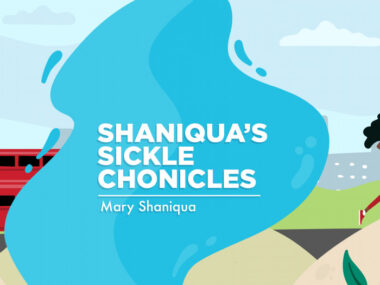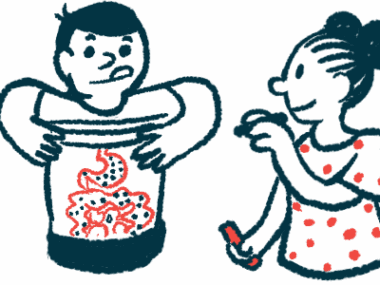What avascular necrosis in sickle cell disease looks like for me
AVN can occur due to the progressive impairment of blood supply to the bones
Written by |

In sickle cell disease, avascular necrosis (AVN) can occur due to the progressive impairment of blood supply to the bones caused by the sickling process. In AVN, the bone tissue dies and the bone collapses, as Johns Hopkins Medicine explains. The sickling process can also cause chronic anemia, blood vessel occlusion (vaso-occlusion), ischemia, oxidative stress, and organ damage. The damage is usually progressive, starting with small areas and becoming more significant over time.
AVN is particularly common in adults with sickle cell disease, and its prevalence increases with age, resulting in bone death due to inadequate blood supply. AVN usually presents with symptoms like chronic pain, limping, a shortening of limbs, an inability to walk well, physical disability, and more.
I’ve often asked sickle cell patients, both in support groups and in person, about their most feared complications. AVN has always made their Top 3 list.
It can happen in multiple areas of the body
As a physician and someone who has experienced AVN firsthand, I’ve noticed a common misconception among healthcare professionals: Many believe that AVN affects only the femoral head (in the hip area). This assumption likely stems from the fact that many hematology textbooks only mention AVN of the femoral head as a complication of sickle cell disease. Yes, AVN mostly affects the head of the femur in sickle cell patients, but it can also affect other areas, such as the knees, shoulders, spine, ankles, and more. There is a need for greater awareness about the condition’s scope.
My first experience with AVN was in my shoulder. I suddenly felt severe pain that made it impossible to move my arm. My physician ordered an X-ray, but it didn’t show anything, which wasn’t surprising since early AVN doesn’t show up on X-rays.
It took over a year for me to regain mobility in my shoulder, and I was in pain for two years, but it subsided over time. I didn’t receive an official diagnosis until a chest X-ray revealed AVN in my left shoulder over two years later.
The real challenge came when I was diagnosed with AVN in both knees. My discharge from the hospital where I was diagnosed with shoulder AVN signaled the onset of this new issue: mild bilateral knee pain, a symptom I’d never experienced before. I assumed it was just a sickle cell crisis and would resolve quickly, but as soon as I attempted to stand up, the pain escalated drastically, going from 10 to 200 fast. The intensity of the pain incapacitated me. I couldn’t walk and had to be transported to a vehicle in a wheelchair.
When I returned home, the struggle to get to my room was daunting. Every effort to walk intensified the pain, which felt like a truck was repeatedly crushing my knees. Consequently, I consulted an orthopedic surgeon who asked for an X-ray. That revealed osteoarthritis in both knees. But that didn’t explain the intense pain.
An MRI was recommended, but since it wasn’t available in my state here in Nigeria, and I wasn’t fit to travel, I opted for a CT scan instead. The CT scan revealed bilateral subchondral fractures in my knees, which is characteristic of stage 3 AVN. This revelation provided me with a sense of relief, as it clarified the reason for my intense pain: a pathological subchondral fracture caused by stage 3 AVN.
After my diagnosis, I was placed on medications and told to rest my knees. Doctors said I’d be fine in three months, but sadly, that wasn’t the case. I spent over a year bedridden, struggling with persistent pain.
After a year, I was advised to use a wheelchair to reduce the strain on my knees, but I refused. However, when I returned to work, the pain came back and I was forced to reconsider. I finally accepted that using a wheelchair was necessary to manage my condition and maintain functionality.
AVN has been one of the most character-defining complications of my sickle cell journey. The chronic pain and physical disability it causes are daunting, and the treatment is often costly, leaving many patients with long-term disability. In my case, even though I can afford treatment, I’ve chosen not to undergo multiple joint replacement surgeries due to my other comorbidities.
If you’re a sickle cell patient experiencing chronic joint or bone pain, it’s crucial to see a doctor. Early diagnosis, supportive treatment, and physical therapy can make a significant difference. There are also other early procedures like core decompression and grafting. If joint replacement surgery is necessary, it’s essential to prepare for it in advance.
Upon diagnosis of AVN, reducing weight-bearing stress on the affected joint and following your doctor’s guidelines can help delay progression.
Note: Sickle Cell Disease News is strictly a news and information website about the disease. It does not provide medical advice, diagnosis, or treatment. This content is not intended to be a substitute for professional medical advice, diagnosis, or treatment. Always seek the advice of your physician or other qualified health provider with any questions you may have regarding a medical condition. Never disregard professional medical advice or delay in seeking it because of something you have read on this website. The opinions expressed in this column are not those of Sickle Cell Disease News or its parent company, Bionews, and are intended to spark discussion about issues pertaining to sickle cell disease.







Nasaka Makunda
Thank you so much for this article. My daughter has sickle cell anaemia (SCA) and her journey with the condition was relatively event free. Occasional pain management with paracetamol and blood transfusions were all she needed until last year when she had what we believed to be a sickling crisis in her left leg. It’s only about 6 months after her initial hospitalisation with the leg pain that additional X-rays and an MRI to determine why the pain was persistent finally confirmed AVN. Within a matter of weeks it had progressed to stage 4. We had never come across AVN and nor had we encountered it in reference to sickle cell anaemia. It’s not the usual complication that’s listed in SCA support resources. It was a shock and her deterioration was fast. She finally had core decompression of the hip surgery a few weeks ago and she’s now pain free, but she has a long road towards recovery as she lost proper use of her left leg and needs to rebuild muscle and relearn how to walk without a limp. Her AVN is bilateral though her right hip remains asymptomatic. She also needed a wheelchair at some point but that was briefly. She does need a crutch to get around. But thank you so much for highlighting this as it’s not common to come across personal stories nor medical articles on AVN and sickle cell anaemia. We have access to some of the best health care in Africa being in South Africa but we discovered that even within the orthopaedic surgeons’ network here there’s is hardly any experience with AVN in such a young patient (she’s now 13) let alone one with sickle cell anaemia. Thanks also for highlighting that it’s effects are not limited to the femoral head- again much of the available information on AVN focuses on the hip. It’s a journey that’s been difficult and we’ve been advised to consider bilateral hip replacement once she turns 18 as nothing can be done at this point except to manage it. Hopefully access to curative therapies/ treatments for SCA will become easier.
Oluwatoyin
Thank you Tosin for sharing. God will help us all to over AVN
Aadey
Thanks for sharing. Just a comment that AVN can also happen to kids with SCD. My 14yr old had to get a core decompression because of AVN of the femoral head. The confounding of SCD pain can make it difficult for early detection in my opinion. This just goes to show that there’s a lot going on with SCD that care providers need to be aware of.
Oluwatosin Adesoye
Ofcourse AVN can happen to children, my article did not state otherwise, It only stated that it is commoner in adults and its prevalence increases with age. All these are proven facts via scientific research. Anytime a sickle cell patient complains of chronic bone pain for over 3 months. It is ideal to request for an MRI of that region. MRI can diagnose early AVN.
Miriam
Thank you for this article.
As an SCA patient, I was diagnosed with AVN of the hips in 2007, and subsequently had hip replacements done. Currently I am living with AVN in both my shoulders, however it has not progressed to the extent of needing replacements. I have had core decompression procedures done in both, which has worked in my right should but not so much the left. Physiotherapy, and especially Hydrotherapy, are treatments that can help in slowing down AVN progression.
In 2019 I experienced excruciating pain in my left jaw, and after some visits to the dentist and my physician, and taking X-rays/MRI it was noted that I had AVN of the jaw. My physician explained wherever there is insufficient blood supply the likelihood of dead bone cells occurring is high.